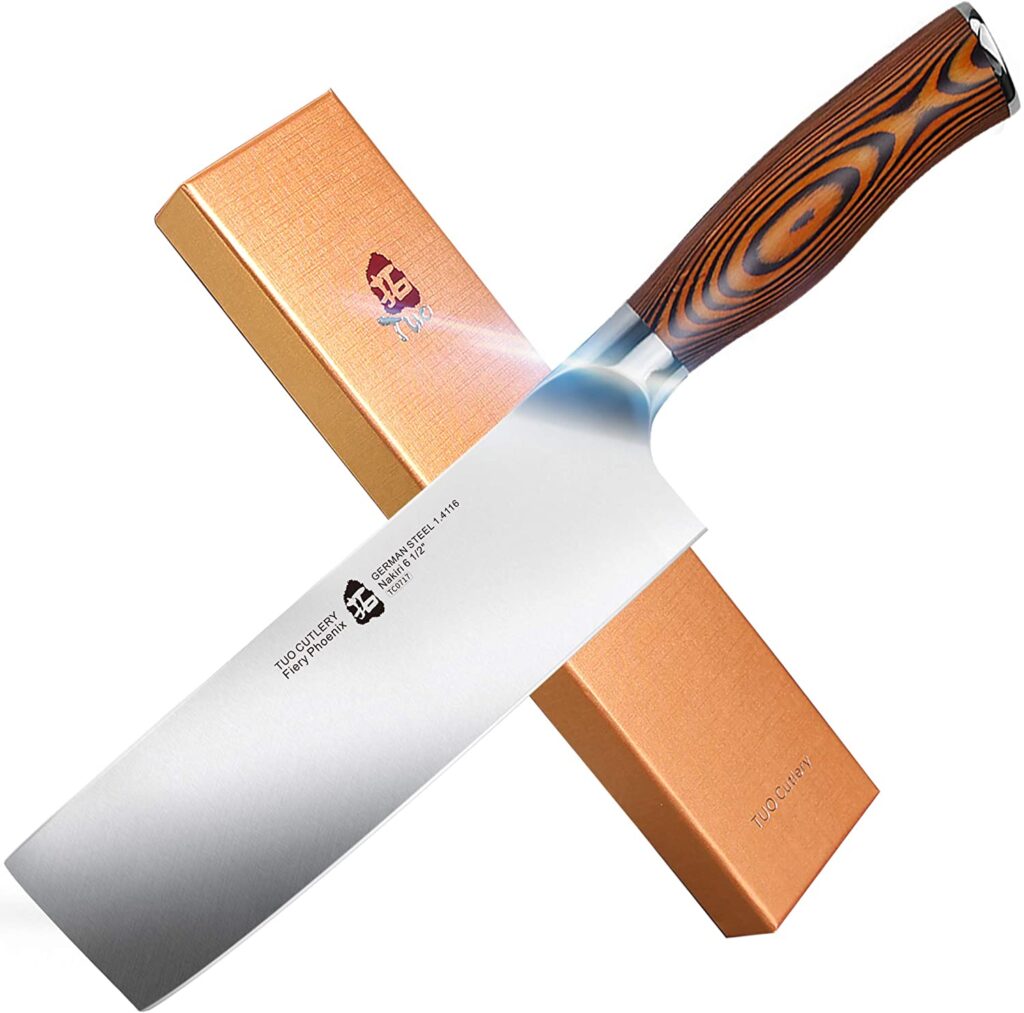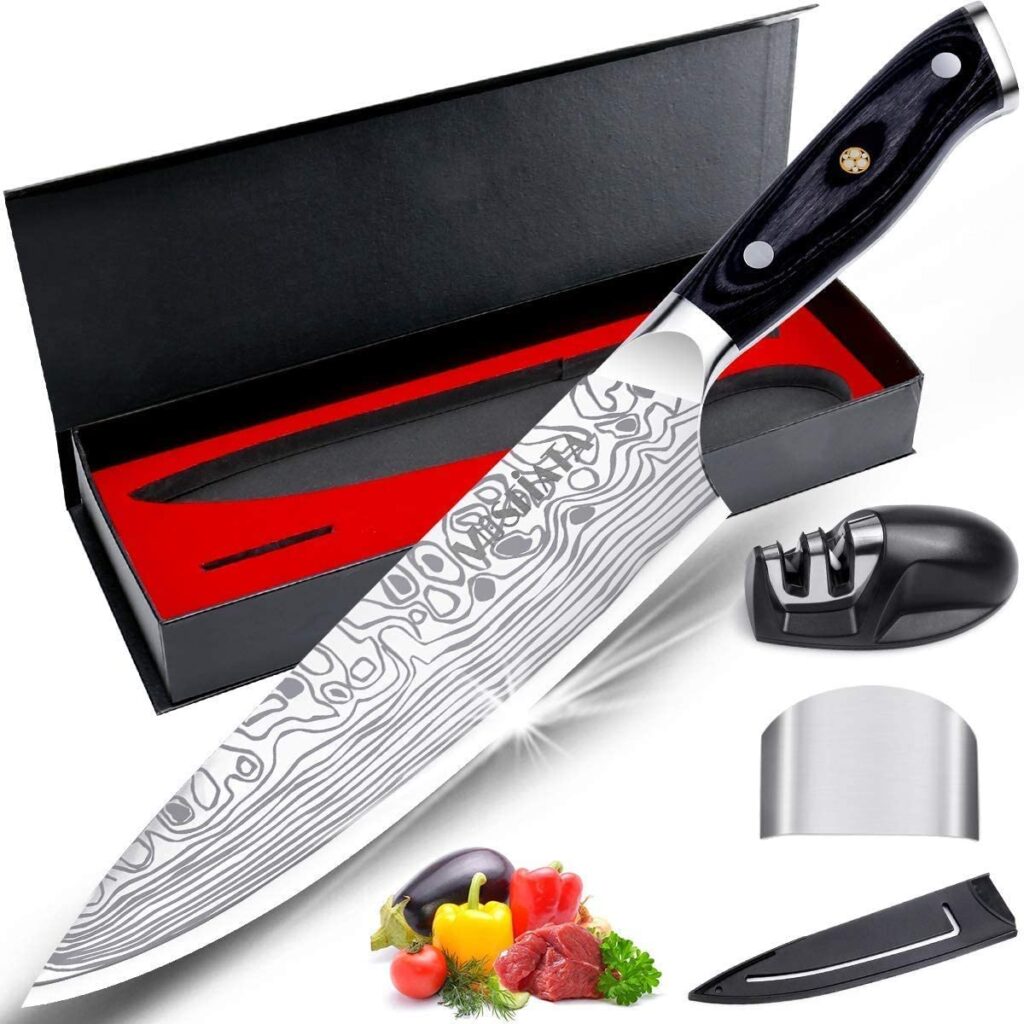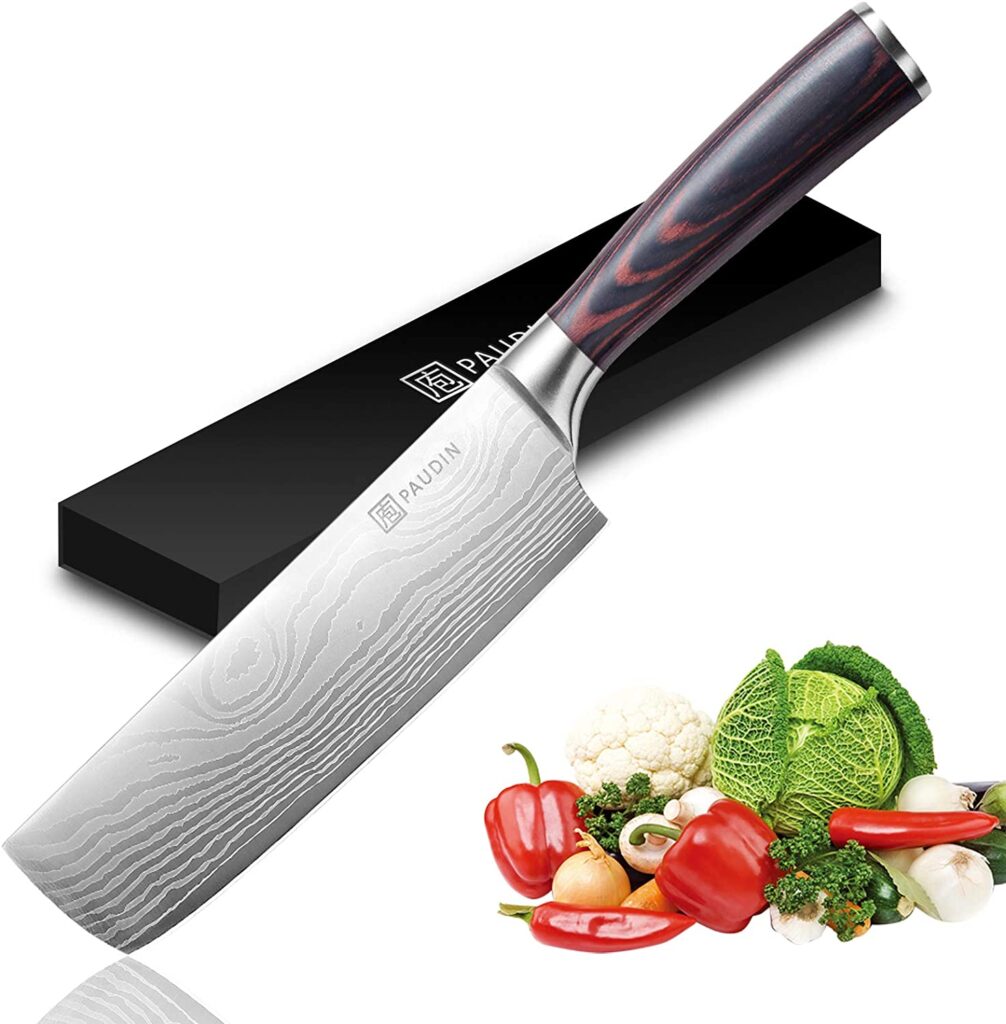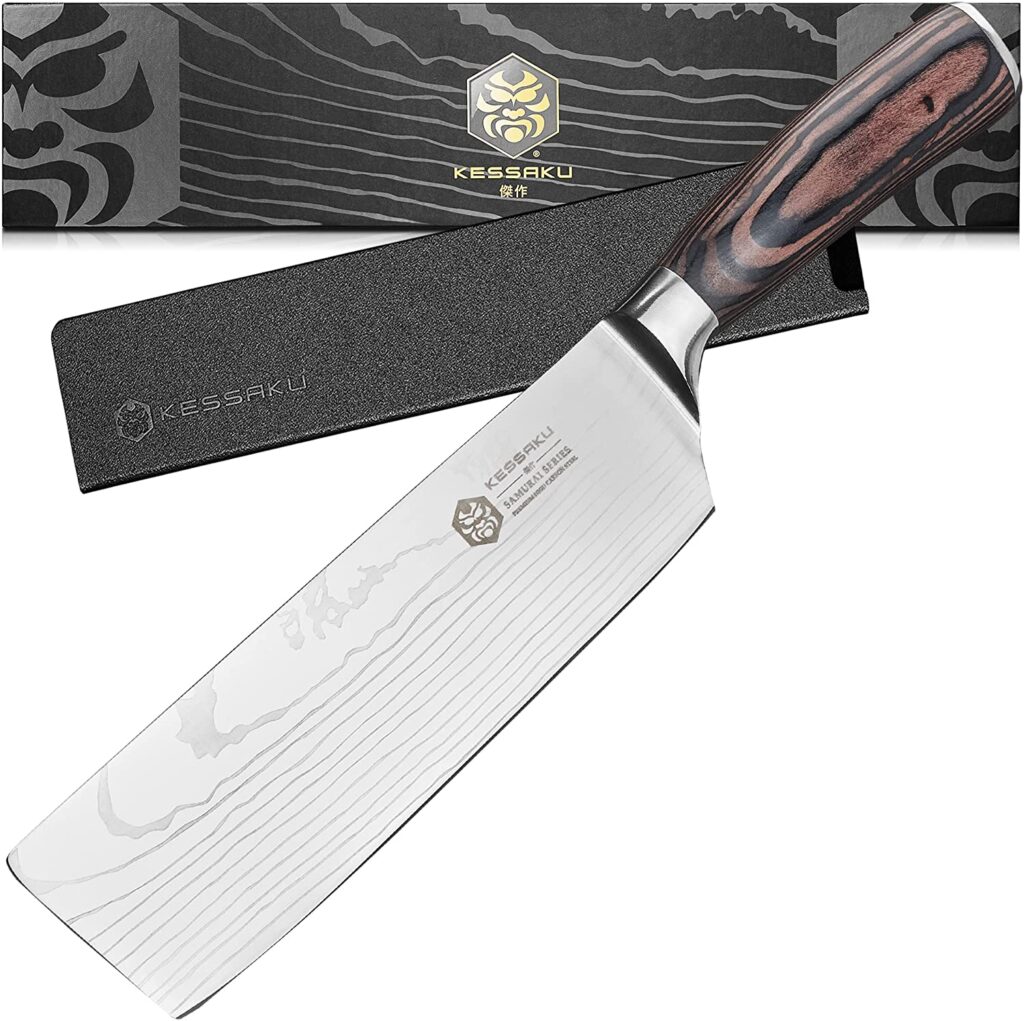Today, we are going to be discussing two special knives, the Nakiri knife vs Chef knife.
Nakiri knife and chef knife have their uses and designs, and they are both used to meet the various everyday tasks.
Nakiri knife and Chef Knife are Japanese-style vegetable knives and they are popular in the Western kitchen. They are general-purpose knives used for cutting, slicing, dicing, and mincing vegetables. The ergonomic handles give you great clearance off the board when you hold them and make it conducive to cut through ingredients.
The Nakiri knife is preferred in terms of cutting and chopping vegetables, onion, potato, and other ingredients but not to cut meat, so as to avoid damaging the knife while the Chef knife is a multi-functional design knife for cutting anything and everything in the kitchen, from meat to tough vegetables.
From the above reasons, they are one of the most commonly used knives in both professional and home kitchens.
NAKIRI KNIFE

Nakiri knife is specially designed for cutting vegetables it has a very thin, sharp blade and a blunt, cut-off tip.
Nakiri knives make straight and even cuts through vegetables, leaving you with full, clean slices without squashing your produce.
A truly all-around cooking knife is easy to re-sharpen, clean, and maintain.
The razor-sharp cutting edge allows you to cut foods effortlessly.
The ergonomics shape perfectly balances the handle and the thin blade at the pinch point and ensures ease of movement.
Nakiri knife can handle all kitchen tasks, chopping, slicing, mincing, and dicing. It is suitable for vegetables, fruits, meats, and other ingredients.
Nakiri is characterized by its flat profile and cut-off tip. When you use a Nakiri, you can do chop up and down with a slightly forward motion.
The Nakiri knife handle is specifically designed to hold comfortably in your hand with great balance.
NAKIRI KNIFE VS CHEF KNIFE

Nakiri is characterized by its flat profile and cut-off tip. When you use a Nakiri, you can do chop up and down with a slightly forward motion. while Chef knife is a multi-functional design knife for cutting anything and everything in the kitchen, from meat to tough vegetables.
The traditional Japanese Nakiri are double beveled knives designed specifically for working with vegetables while the chef knife is a multipurpose knife that is ideal for various tasks which include cutting, chopping, dicing, and slicing vegetables, fruits, fish, meat, and other products. It is also ideal for removing flesh from bones as well as pounding /smashing garlic.
The Nakiri is extremely sharp and thin, providing you with smooth, clean cuts and chops all the way down to the cutting board While Chef Knife Ultra has a sharp curved edge for easy slicing, mincing, and dicing.
Both the Nakiri and Chef knives have non-stick blade coating that keeps food from sticking to the knife while cutting.
Both the Nakiri knife and chef knife have ergonomic comfortable handles that feel balanced and easy to use without worry.
The Nakiri knife and chef knife have a non-slip ergonomic handle with a lightweight and comfortable grip that makes long hours in the kitchen easy.
The blade length of a Nakiri knife is 6 to 7 inches while the chef knife has about 8 to 9 inches.
The spine of the Nakiri knife has a sharp edge while the spine of the chef’s knife is thin and has a fine polish.
READ ALSO: BEST CUTTING BOARD FOR JAPANESE KNIVES
READ ALSO: BREAKING KNIFE VS CIMETER
BEST NAKIRI KNIFE
Nakiri knife is capable when slicing and chopping fruits and vegetables with precision and speed.
below are the best Nakiri knife;
PAUDIN, 7 INCH NAKIRI KNIFE.

PAUDIN Nakiri knife can handle all kitchen tasks, chopping, slicing, mincing, and dicing. It is suitable for vegetables, fruits, meats, and other ingredients. It is also an essential tool for precision preps work at home kitchen and restaurant
This cooking knife is easy to re-sharpen, clean, and maintain.
The razor-sharp cutting edge allows you to cut foods effortlessly.
The ergonomics shape perfectly balances the handle and the thin blade at the pinch point ensures ease of movement.
Pakka wood handle is comfortable, non-slip, and easy to control.
The handle of this Paudin Nakiri is made of non-slip pakka wood to ensure safety, and effectively reduce fatigue caused by prolonged use.
Hand wash is recommended for this Nakiri knife, not safe in the dishwasher.
NOTE: Do not cut bones with a Nakiri knife.
Don’t use this knife as a can opener.
KESSAKU 7-INCH NAKIRI VEGETABLE KNIFE

This great-looking knife is designed by artisans in Japan; our Samurai Series Nakiri Knife features a perfectly balanced & ergonomic grip for amazing comfort & safety.
This traditional Nakiri knife has been re-designed with modern refinements to be sleek, fast, aerodynamic, and highly engineered for precision and maneuverability.
The blade is made from specially formulated high carbon 7cr17mov stainless steel for enhanced corrosion resistance and non-stick properties.
Its Mirror-Polished Smooth Pakka Wood handle offers amazingly superior Full Tang strength.
It is a perfect gift for a Birthday, Wedding, Anniversary, Mother’s Day, Father’s Day, Christmas, House Warming, etc. Give this to your favorite chef.
SANTOKU KNIFE
The Santoku blade is designed specifically for straight cutting tasks such as chopping, mincing, dicing, and slicing. It is also used for filleting and disjointing large cuts.
SANTOKU VS CHEF KNIFE

Santoku knife is a multipurpose kitchen knife and it is used to take care of meat, fish, vegetables, and other ingredients for cooking tasks.
In terms of design, Santoku is light, thinner, and shorter with hardened steel while the chef is made with blades that are either forged or stamped.
Santoku blade length is between 6 and 7 inches while chef’s blade length is between 8 and 14 inches.
Santoku’s blade and handle are designed to work in agreement to give its user the desired pieces of meat. The handle of chef’s knives is made of either wood or plastic in such a way as to make its usage comfortable, functional, and easy in the kitchen.
Santoku knives have a different way of chopping and slicing through the food. Santoku knives work in the up and down motion while chef knives need a rocking and forth motion.
Santoku knives are better suited to precision cutting, where you need really thin cuts but it is harder to achieve the same level of precision with a chef’s knife.
Santoku Japanese knife has a rectangle blade while chef knife has a curved edge.
NAKIRI VS USUBA KNIFE

The Nakiri knife has a straight blade and a flat font while the Usuba knife has a straight, thin, and flat front.
The Nakiri knife is a double bevel blade while the Usuba knife is a single bevel blade.
In terms of sharpness, the Nakiri knife is easy to sharpen while the Usuba knife needs extra skill to sharpen the blade.
The Nakiri is lighter than Usuba.
Both the Nakiri and Usuba are used for chopping vegetables, but the Nakiri knife is a perfect one for chopping.
In terms of price, the Nakiri knife is cheaper while the Usuba knife is expensive
NAKIRI VS GYUTO
Gyuto knife has a sharp tip for precision cutting, they are also good for chopping, slicing, and mincing basically anything while Nakiri knives have a rectangle, straight and thin blade to typically slice through the vegetable.
The blade length of Nakiri ranges from 6.5 to 7 inches while the Gyuto blade length range from 9 to 10 inches.
Nakiri blade allows its owner to use a push and pull motion to slice through ingredients, specially vegetables while Gyuto allows its owner to use rocking chop motion.
READ ALSO: NAKIRI VS CHEF’S KNIFE
- Carbon Steel Pans for Wood Fired Oven - March 22, 2025
- Cookware for Wood Fired Oven - March 21, 2025
- Cast Iron Dutch Oven Pros and Cons - March 19, 2025